FRIDAY, NOVEMBER 20
■ Whenever Fomalhaut, the Autumn Star, is "southing" (crossing the meridian due south, which it does around 7 or 8 p.m. this week), the first stars of Orion are just about to rise above the east horizon for the world's mid-northern latitudes. And, the Pointers of the Big Dipper stand upright low due north, straight below Polaris.
Starting from that time, it takes Orion's figure about an hour and a half to completely clear the horizon.
SATURDAY, NOVEMBER 21
■ First-quarter Moon (exact at 11:45 p.m.). The Moon shines between dim Aquarius and Capricornus. Look to its lower left for Fomalhaut.
■ The bowl of the Little Dipper is descending in the evening at this time of year, left or lower left of Polaris. By about 11 p.m. it hangs straight down from Polaris.
■ As dawn brightens on Sunday morning the 22nd, Mercury is still nicely visible in the east-southeast. Look for it lower left of Venus as shown below. Day by day it will descend toward the dawn horizon and out of sight.
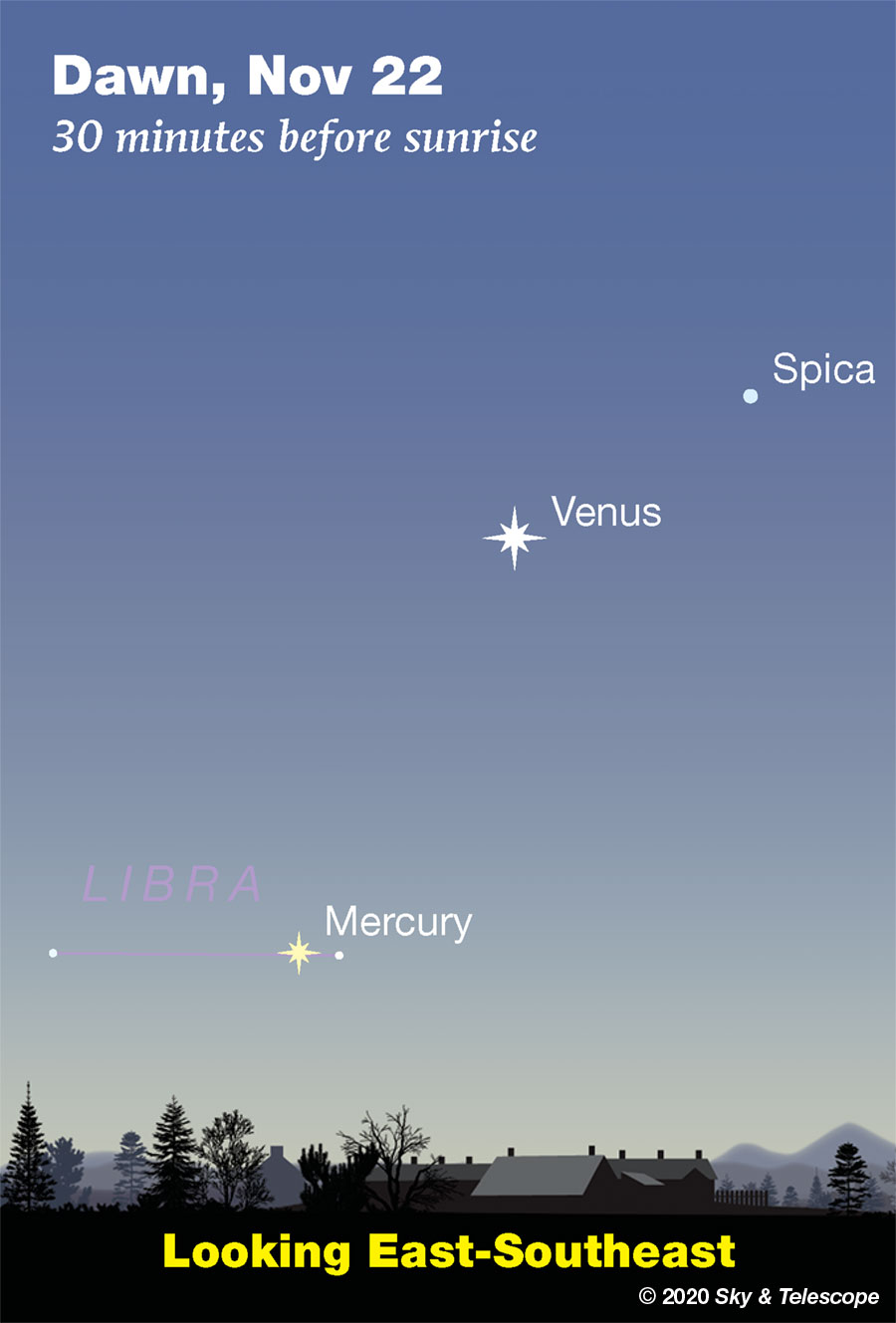
The visibility of the faint objects in bright twilight is greatly exaggerated here. Even Mercury, and then Venus, become difficult as day approaches.
SUNDAY, NOVEMBER 22
■ Today we're two thirds of the way through fall, so Capella shines in the northeast as soon as the stars come out.
As night grows dark, look to Capella's right by about three fists at arm's length for the frosty little Pleiades cluster, the size of your fingertip at arm's length.
MONDAY, NOVEMBER 23
■ Two faint fuzzies naked-eye: The Andromeda Galaxy (M31) and the Perseus Double Cluster are two of the most famous deep-sky objects. They're both cataloged as 4th magnitude, and in a fairly good sky you can see each with the unaided eye. Binoculars make them easier. They're only 22° apart, very high toward the east early these evenings — to the right of Cassiopeia and closer below Cassiopeia, respectively.
But they look rather different, the more so the darker your sky. See for yourself! You can find them with the all-sky constellation map in the center of the November or December Sky & Telescope.
TUESDAY, NOVEMBER 24
■ Mars shines about a fist-width to the upper left of the waxing gibbous Moon this evening, as shown below.
Mars has lost two thirds of the brightness it displayed around opposition in early October. But at magnitude –1.4 it's still as bright as Sirius, which will be up and shining low in the southeast after midnight. At that time, Mars will be very high in the southwest.
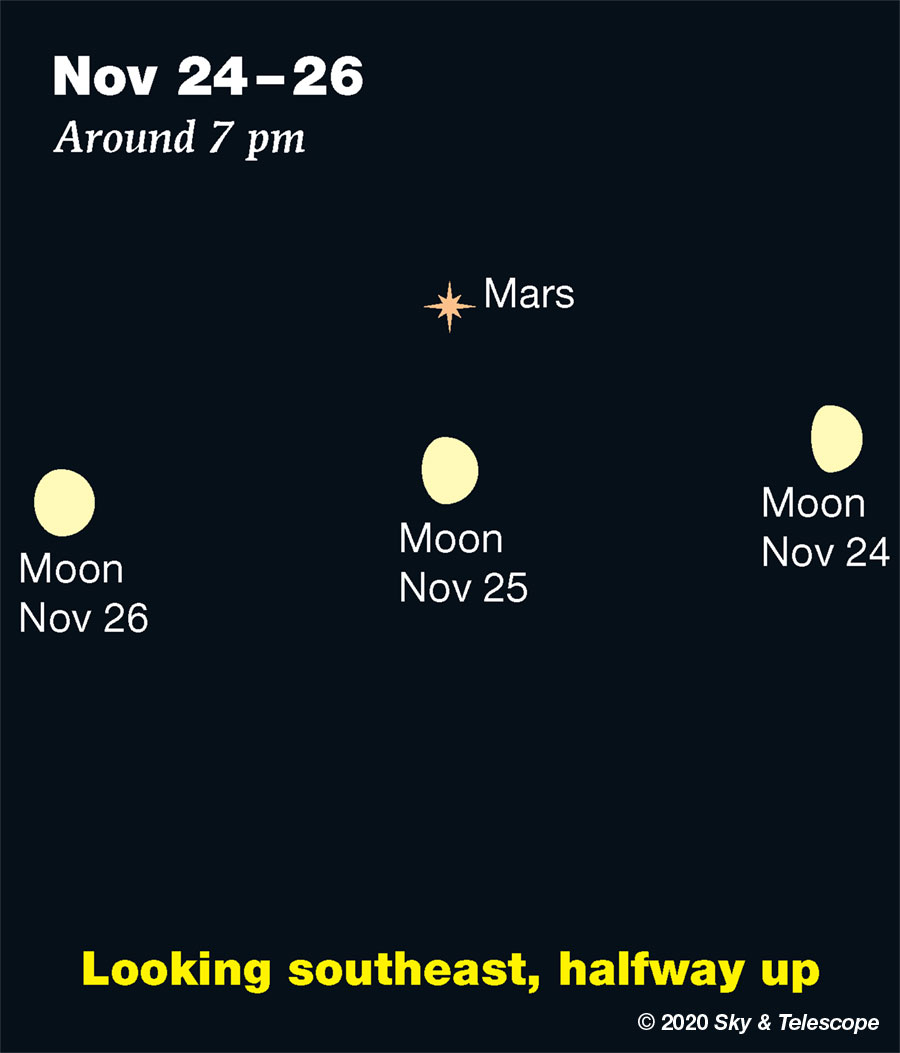
■ Around 8 p.m. the Great Square of Pegasus stands level very high toward the south (straight overhead if you're as far south as Miami). Its right (western) edge points very far down toward Fomalhaut. Its eastern edge points less directly toward Beta Ceti, less far down.
Now descending farther: If you have a very good view down to the south horizon, and if you're not much farther north than latitude 40° (roughly Denver, New York, or Madrid), picture an equilateral triangle with Fomalhaut and Beta Ceti as its top two corners. Near where the third corner would be (a bit to the right of that point) is Alpha Phoenicis, or Ankaa, in the constellation Phoenix. It's magnitude 2.4, not very bright but the brightest thing in its area. It has a yellow-orange tint; binoculars help confirm this. Have you seen anything of the constellation Phoenix before?
WEDNESDAY, NOVEMBER 25
■ Mars shines about 5° above the waxing gibbous Moon high in the southeast in early evening, as shown above. These are currently the two closest large celestial bodies; they're 1.3 light-seconds and 5 light-minutes away. Next is the Sun at 8.3 light-minutes. Mercury and Venus are both currently on the far side of the Sun.
THURSDAY, NOVEMBER 26
■ The early Thanksgiving sunset. Does the Sun already seem to be setting about as early as it ever will? You're right! We're still nearly a month from the winter solstice on December 21st — but the Sun sets its earliest around December 7th if you live near latitude 40° north. And already the Sun sets within only two minutes of that time.
A surprising result of this: The Sun actually sets a trace earlier on Thanksgiving than on Christmas — even though Christmas is around solstice time!
This offset from the solstice date is balanced out by the opposite happening at sunrise: The Sun doesn't come up its latest until January 4th. Blame the tilt of Earth's axis and the eccentricity of Earth's orbit.
FRIDAY, NOVEMBER 27
■ Bright Jupiter and Saturn are almost as close together now (2.6° apart) as modest, 3rd-magnitude Alpha and Beta Capricorni above them (2.3° apart); see below. Wait for full dark to catch the faint stars.
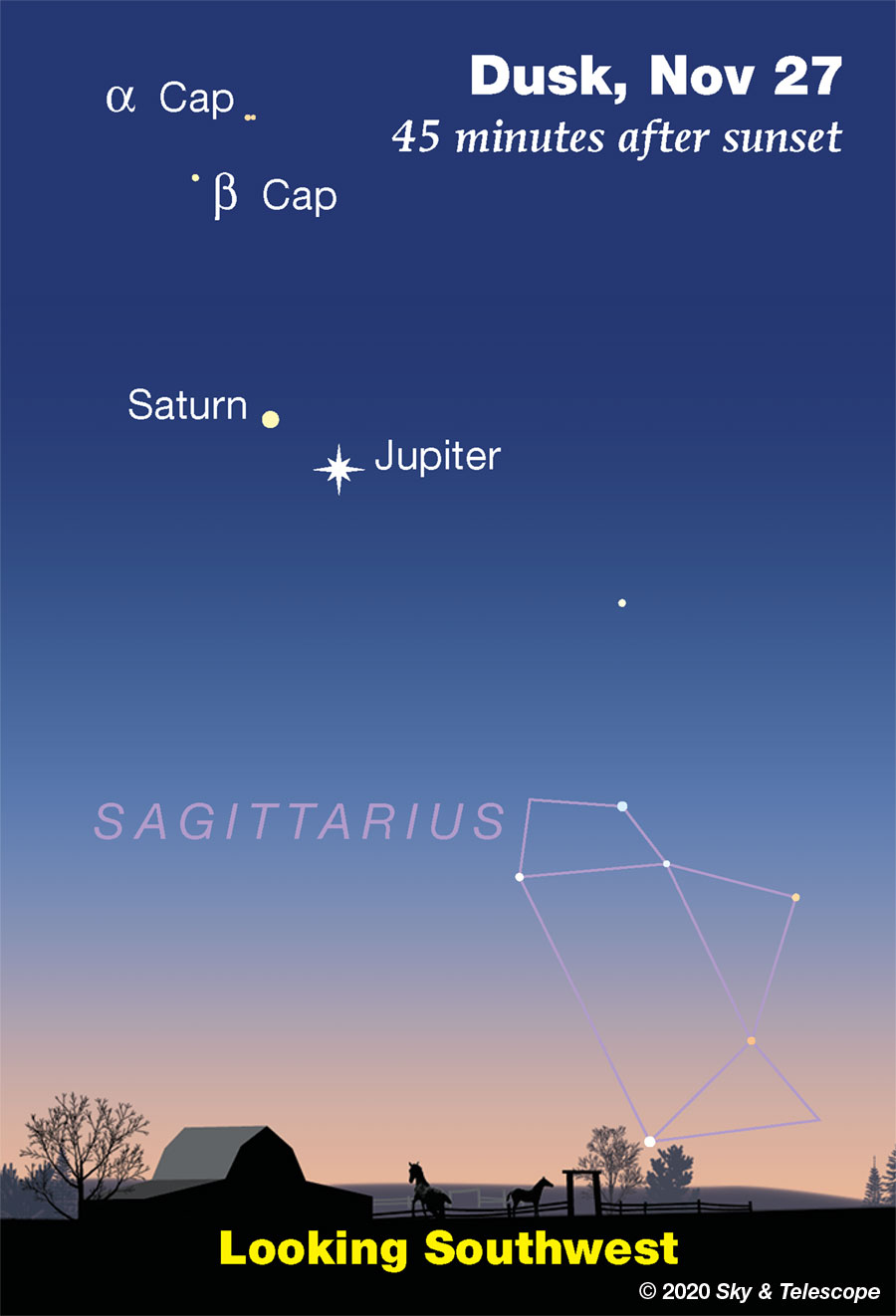
SATURDAY, NOVEMBER 28
■ This evening the bright, almost-full Moon shines between Aldebaran below it and the Pleiades above it. Off to their left, bright Capella looks on.
This Week's Planet Roundup
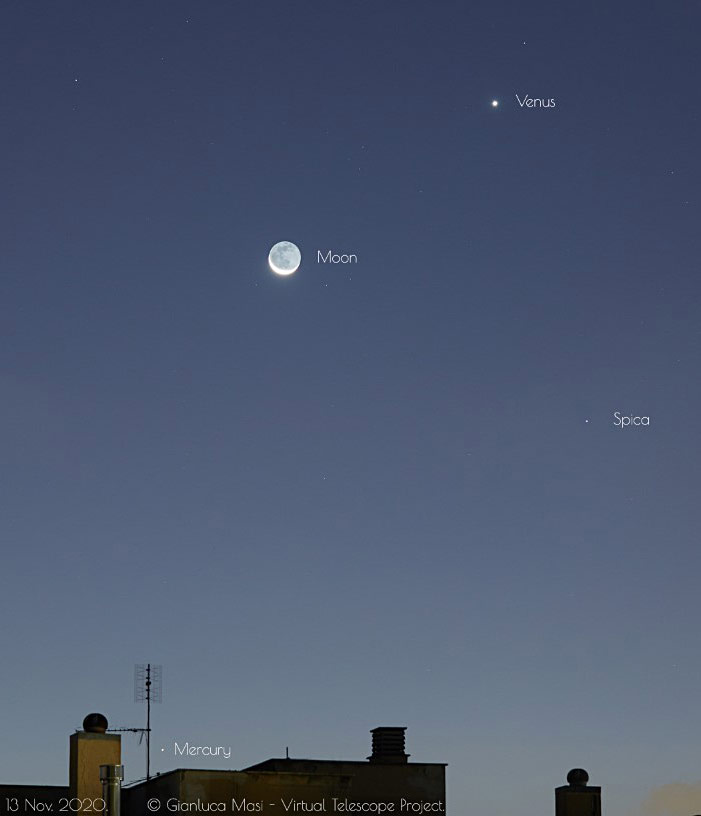
This week the Moon is gone, you'll now find Spica to Venus's upper right, and Mercury will be even lower.
Mercury (magnitude –0.7) sinks low into the glow of sunrise this week. About 45 to 30 minutes before sunrise, look for it below or lower left of bright Venus by about 15° (roughly a fist and a half at arm's length). The earlier in the week the better.
Venus (magnitude –3.9, in the feet of Virgo) is also moving lower in the dawn, but it's higher and much more obvious as the bright "Morning Star."
Look for Spica, only 1% as bright at magnitude +1.0, increasingly far to Venus's upper right.
Mars (about magnitude –1.3, in Pisces) shines bright yellow in the east-southeast at dusk. Above it is the Great Square of Pegasus. Mars is six weeks past opposition and shrinking into the distance, but it's still 16 or 15 arcseconds wide in a telescope, quite big enough to show surface detail during steady seeing. The South Polar Cap has shrunk to a tiny white speck. Yellow dust storm activity has begun in the Chryse region and has spread south.
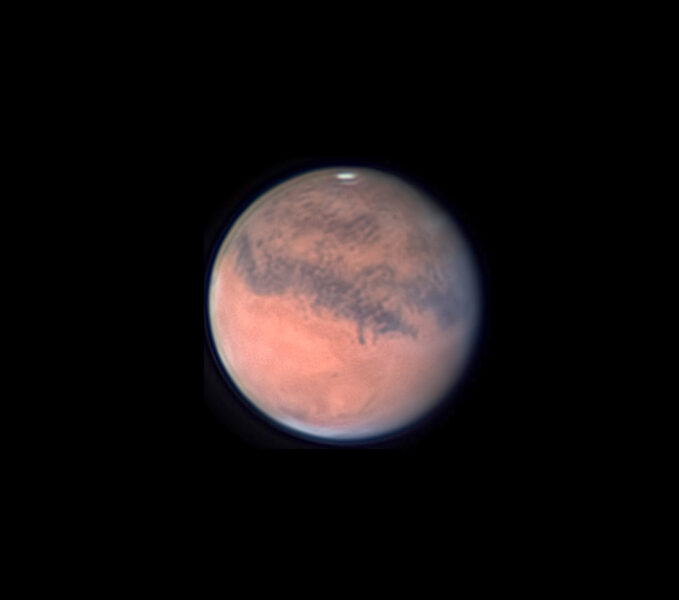
These classical names refers to the albedo (bright/dark) markings, which mostly have to do with surface dust and rock exposure. In terms of physical geography, on the other hand, the bottom of Gomer Sinus is Gale Crater, home of the Curiosity rover for the last five years.
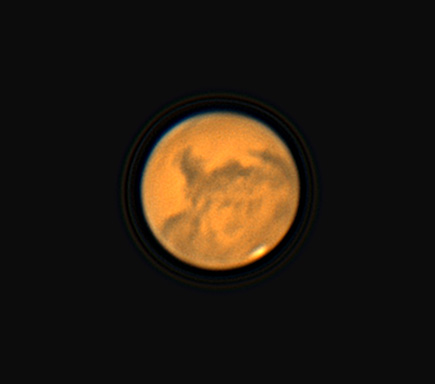
To get a map of the side of Mars facing Earth at the date and time you observe, you can use our Mars Profiler. The map there is square; remember to mentally wrap it onto the side of a globe. (Features near the map's edges become very foreshortened.)
Jupiter and Saturn (magnitudes –2.1 and +0.6, respectively) tilt ever farther down in the southwest during and after twilight. Look early. Jupiter is the bright one; Saturn is upper left of it. Watch their separation shrink from 3.3° to 2.3° this week, from November 20th to 27th.
Don't expect a decent view in a telescope; they're farther and smaller than they were last summer, and the low-altitude seeing will be poor.
Jupiter and Saturn will pass just 0.1° apart at their conjunction on December 21st, low in the glow of sunset. The two giants have conjunctions about every 20 years — but this will be their closest one visible since March 4, 1226.
Uranus (magnitude 5.7, in Aries) is high in the east in early evening, about 22° east (lower left) of Mars. Uranus is only 3.7 arcseconds wide, but that's enough to appear as a tiny fuzzy ball, not a point, at high power in even a smallish telescope with sharp optics.
And while you're there, find the 9th-magnitude asteroid 8 Flora about 11° away. See Bob King's Tiny Asteroid Flora and Mighty Uranus Team Up, with finder charts and more about both.
Neptune (magnitude 7.9, in Aquarius) is equally high in the south in early evening. Neptune is 2.3 arcseconds wide, harder to resolve than Uranus except in very good seeing. Check in on all three of these faint targets when you're done with Mars. Finder charts for Uranus and Neptune.
All descriptions that relate to your horizon — including the words up, down, right, and left — are written for the world's mid-northern latitudes. Descriptions that also depend on longitude (mainly Moon positions) are for North America.
Eastern Standard Time, EST, is Universal Time minus 5 hours. (Universal Time is also known as UT, UTC, GMT, or Z time.)
Want to become a better astronomer? Learn your way around the constellations. They're the key to locating everything fainter and deeper to hunt with binoculars or a telescope.
This is an outdoor nature hobby. For an easy-to-use constellation guide covering the whole evening sky, use the big monthly map in the center of each issue of Sky & Telescope, the essential magazine of astronomy.
Once you get a telescope, to put it to good use you'll need a detailed, large-scale sky atlas (set of charts). The basic standard is the Pocket Sky Atlas (in either the original or Jumbo Edition), which shows stars to magnitude 7.6.

Next up is the larger and deeper Sky Atlas 2000.0, plotting stars to magnitude 8.5; nearly three times as many. The next up, once you know your way around, are the even larger Interstellarum atlas (stars to magnitude 9.5) or Uranometria 2000.0 (stars to magnitude 9.75). And be sure to read how to use sky charts with a telescope.
You'll also want a good deep-sky guidebook, such as Sky Atlas 2000.0 Companion by Strong and Sinnott, or the bigger (and illustrated) Night Sky Observer's Guide by Kepple and Sanner.
Can a computerized telescope replace charts? Not for beginners, I don't think, and not on mounts and tripods that are less than top-quality mechanically, meaning heavy and expensive. And as Terence Dickinson and Alan Dyer say in their Backyard Astronomer's Guide, "A full appreciation of the universe cannot come without developing the skills to find things in the sky and understanding how the sky works. This knowledge comes only by spending time under the stars with star maps in hand."
![]() Audio sky tour. Out under the evening sky with your
Audio sky tour. Out under the evening sky with your
earbuds in place, listen to Kelly Beatty's monthly
podcast tour of the heavens above. It's free.
"The dangers of not thinking clearly are much greater now than ever before. It's not that there's something new in our way of thinking, it's that credulous and confused thinking can be much more lethal in ways it was never before."
— Carl Sagan, 1996
"Facts are stubborn things."
— John Adams, 1770
 8
8








Comments
Rod
November 20, 2020 at 9:34 am
mary beth, New Jersey Eclipse Fan. Venus and Spica this morning very lovely view in Virgo. Here is a note from my stargazing log. [Observed 0515-0615 EDT/1015-1115 UT. Sunrise 0655 EST/1155 UT. Venus and the star HIP 67271, 30' angular separation this morning in Virgo according to Starry Night. Easy view using 25-mm plossl at 40x. I could see Venus distinct planet, gibbous shape (86% illuminated), and the much fainter star in FOV. Venus 1.379 AU from Earth, HIP67271 star more than 500 LY distance. Using 10x50 binoculars I could place Venus, HIP 67271, and 82 Virginis in the binocular FOV. Quite a lovely early morning sight with bright Spica in Virgo too using unaided eyes along with Venus. Venus apparent magnitude shows the planet in the eyepiece more than 9500x brighter than HIP 67271 star, mv + 6.03 or 6.4 according to Stellarium 0.20.3.
Mercury rose shortly after 0531 EST and a deer hunter came out early for bow season, setting up before sunrise in the fields NW of my location. Mercury was behind a tree line nearby while I enjoyed telescope and binocular views of Venus this morning, so I did not observe Mercury.]
I also posted a note for 18-Nov when after sunset I enjoyed telescope views of Mars, Neptune, Saturn, and Jupiter. Great fun this fall 🙂
You must be logged in to post a comment.
mary beth
November 22, 2020 at 10:53 pm
This has been a wonderful year for astronomy..(bad for everything else)! glad you’ve had lots of clear nights so you have been able to see so many things. Do you think you’ll be able to see mercury another time? Oh I did see your comment on last weeks post but it was real late Thursday night and I didn’t know if you would go back and check if I replied since they were going to post this week’s column.
Mostly clear skies here. The moon was beautiful when it was dangling below Saturn and Jupiter earlier this week.
You must be logged in to post a comment.
New Jersey Eclipse Fan
November 23, 2020 at 12:28 am
Thanks Rod & Mary Beth, as usual. Glad to hear the skies cooperated. Not so much here in Central Jersey this weekend, but it's supposed to clear up in time to watch a 47° ISS flyover beginning around 5:33pm Monday evening. I'll take it!
You must be logged in to post a comment.
mary beth
November 23, 2020 at 11:45 am
Hi NJEF! Hope it stays clear for that nice long, high fly over. Saw a real good one here last week too! Happy Thanksgiving !
You must be logged in to post a comment.
New Jersey Eclipse Fan
November 23, 2020 at 1:02 pm
Thanks, you too. There was a flyover Friday night (during dinnertime, of course) and I remembered five minutes too late. I went outside anyway, as if the ISS (& docked SpaceX Dragon capsule) had slowed down just so I could wave to it. 😉
You must be logged in to post a comment.
astrageekette
November 20, 2020 at 3:00 pm
Gosh, can't believe I've never tried this, but would Saturn's rings and/or Jupiter's moons be visible during full moon 11-28? With both planets setting fast, and the full moon in the southeast, maybe so?
You must be logged in to post a comment.
Rod
November 20, 2020 at 8:32 pm
astrageekette, yes. I checked Starry Night and the waxing gibbous Moon is in Aries, Saturn and Jupiter very low (3-5 degrees altitude) in SW sky near 8:00 PM EST for my location in Sagittarius. I use a 90-mm refractor telescope and do not find it difficult to view Saturn and Jupiter even 2 degrees from the Moon as my stargazing log shows for 15-July-2019. "Observed 2250-2315 EDT. I could see the waxing gibbous Moon and Saturn in same FOV using 10x50 binoculars. The Full Moon 16-Jul-19 at 2138 UT or 1738 EDT...Using the 25-mm plossl at 40x, I could see Saturn, rings, and Titan near 2:00 position, north up, mirror reverse view."
You must be logged in to post a comment.
astrageekette
November 21, 2020 at 11:58 am
Thanks for the log, Rod. Sold! Some new club members who are also new again to astronomy have time off during Thanksgiving holiday. Did not want to dissuade them from visiting our club's dark sky site by telling them of the full moon, but one especially joined to see the planets. I do double stars any clear night; don't know why I care about moon phase for so much that's still visible. Going to have to work on my DSO-bigoted ways. Thanks!
You must be logged in to post a comment.
You must be logged in to post a comment.